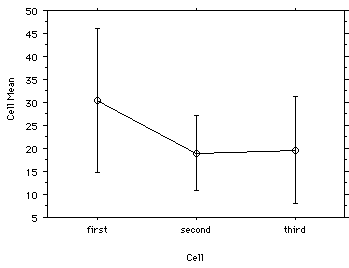Example of a poorly written lab report with comments highlighted in parenthesis
Return to Laboratory report Instruction main page
Example of a well-written lab report
Lab Report #3 (title uninformative)
Carey (not enough information)
Abstract
Adult male mating behavior suggested that the change in color from fifth instars to adults might enable males to discriminate between nymphs and adults. Mating experiments were performed. The null hypothesis that dorsal color pattern does not affect male mating behavior was tested. (Lacks background information. What organism? Not enough detail about methods and what was measured. No results)
Missing "Introduction" heading
"Ontogenetic color change at the time of sexual maturation is advantageous to fish." (Fricke 1980). This is also true in reptiles. (Little background theory. Use of a direct quote. Information without a citation.) The mating behavior of male Largus californicus suggests that males may be using visual cues, perhaps in addition to pheromonal cues, to distinguish between fifth instars and adults for mating attempts. Fifth instars are shiny blue-black and almost adult sized. Adults (both males and females) are black with orange borders around the thickened portion of the hemelytra and pronotum (Booth, 1990). Although males were never observed to mount nymphs, they do mount other adults, and persist if they have mounted a female and release within a few seconds if they have mounted another male. Their distinctive courtship behavior allows an observer to identify immediately the initiation of a mating event. This consists of the male orienting towards the female when he is approximately 1 cm away, rapidly waving his antennae, leaping onto the female's back, and agitatedly grabbing the female with his legs. As their genitals do not immediately join, it is possible to separate a pair before they actually mate.
These bugs do not fly and are easily handled and painted without significantly disrupting their normal behavior. Mating experiments were performed to prove the hypothesis that males use the color to distinguish between fifth instars and adults. (Not enough detail about experiment. No null hypothesis. Starting out biased by attempting to prove alternate hypothesis.)
Materials and Methods
See lab handout for details. (Do not assume reader has access to handout)
Materials: black paint, clear paint, bugs, boxes
The three treatments will be referred to as normal, clear, and black for brevity.
After each painting, place the female in a clear plastic box. Introduce each male one at a time into the box at the point farthest from the female. Record the time to mount. Do the same for the controls. (Lacking important details, listing of chemicals and apparatus, undefined codes, no sample size, written as instructions, statistical analyses not mentioned.)
Results
See Figures and Tables. Males mounted black painted females in 62.5 sec on average. Males mounted clear painted females in 35.4 sec on average. Males mounted normal females in 43.9 sec on average. (Sentence one does not say anything. Does not give information about each table and figure separately. List of numbers repeated from table. Ignores ANOVA p values and fails to address null hypothesis.)
Discussion
The null hypothesis was accepted. Other experiments are necessary to determine the nature of the communication between adults and between adults and nymphs.
(Null hypothesis not repeated. Cannot reject the null hypothesis rather than accepting it. What do the results mean? Not compared to other published results. Be more specific about other experiments.)
References
Fricke, H. W. 1980. Juvenile-adult colour patterns and coexistence in the territorial coral reef fish Pomacanthus imperator. Mar. Ecol. 1 (Needs page numbers. Not in alphabetical order.)
Booth, Carey. Biology of Largus californicus (Hemiptera: Largidae). Southwestern Naturalist 35: 15-22 (1990). (Should use initials only. Date goes after name. Underline species name.)
Zdarek, J. 1970. Mating behaviour in the bug, Pyrrhocoris apterus L. (Heteroptera): ontogeny and its environmental control. Behaviour 37: 253-268. (Not cited in text of report, should not be here.)
Bio 101 lab handout (Incomplete reference. Not cited properly in text either.)
Figure 1. Repeated measures ANOVA
|
|
|
|
1.42 2,28 0.26 |
||||||||||||||||
|
|
|
|
1.34 2, 26 0.28 |
(Should be Table 1 as it is not a figure. Insufficient caption. Columns not labeled. Lacks information describing the experiment in footnotes)

Figure 1: Mean male mount time (sec) under three experimental conditions.
(Insufficient legend, treatments not defined, vertical lines not defined)

Figure 1-B:
(Should be Figure 2. Lacks a legend. Axis labels uninformative. Should have same y-axis scale as first figure for ease of comparison)